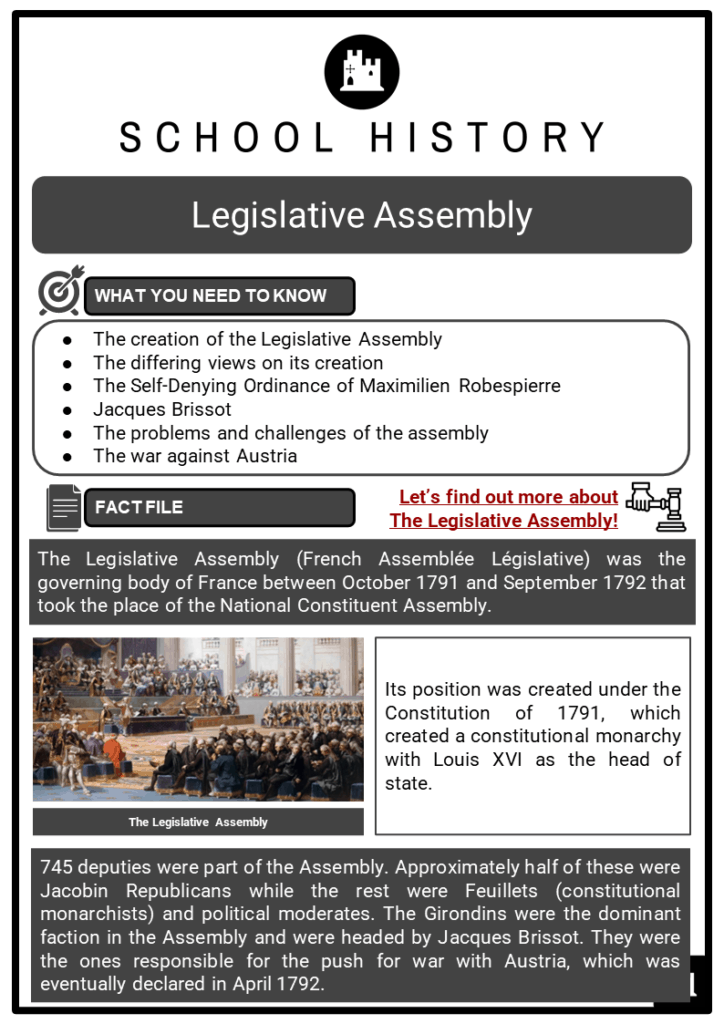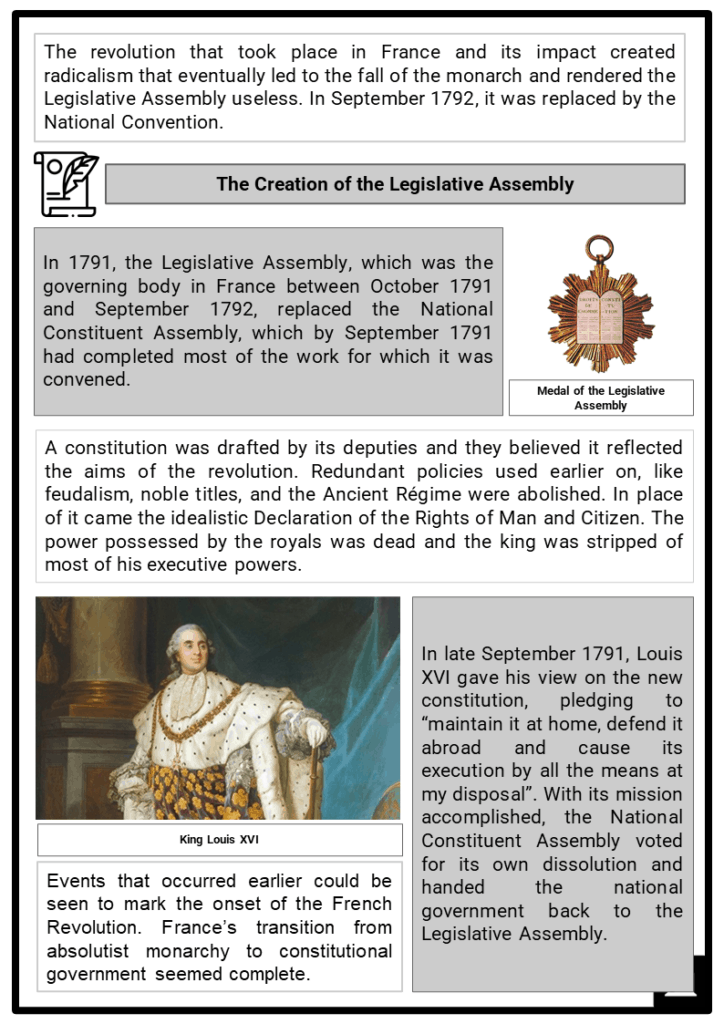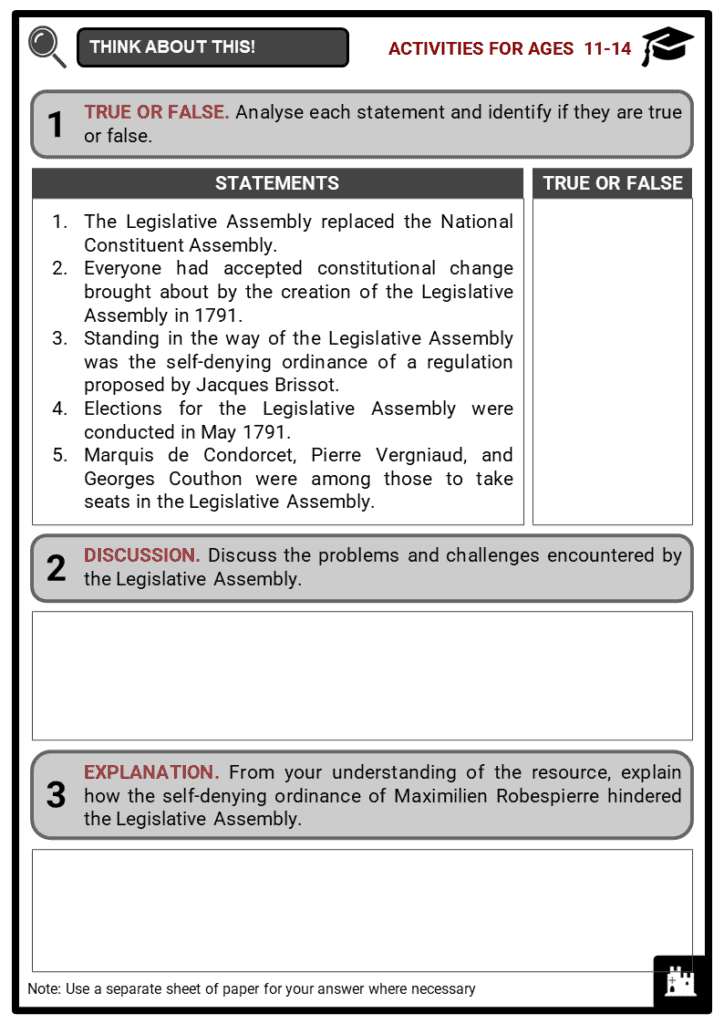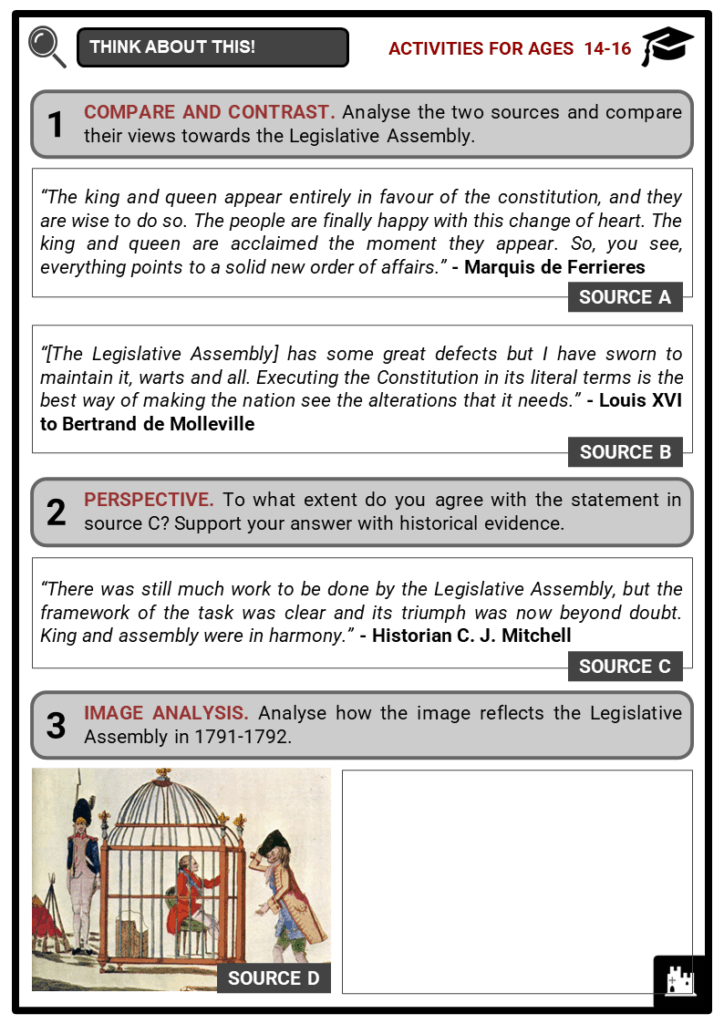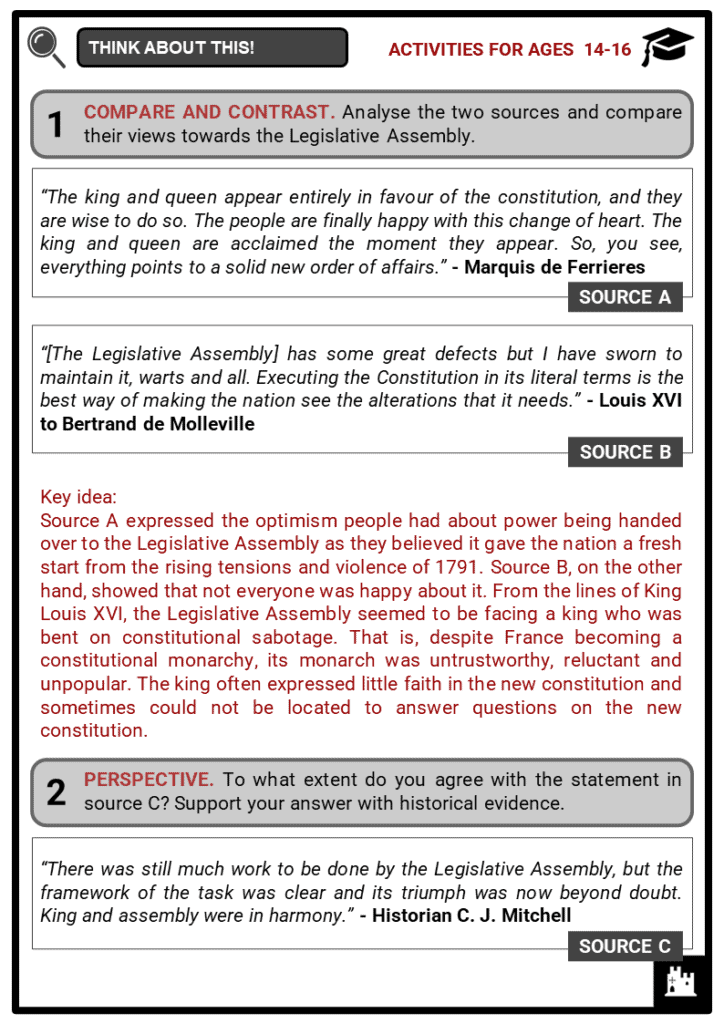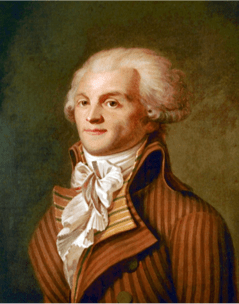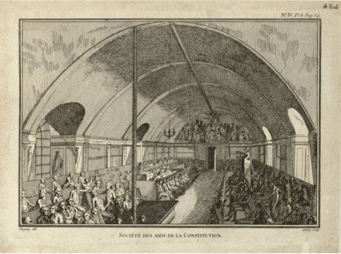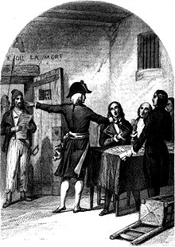Download Legislative Assembly Worksheets
Do you want to save dozens of hours in time? Get your evenings and weekends back? Be able to teach Legislative Assembly to your students?
Our worksheet bundle includes a fact file and printable worksheets and student activities. Perfect for both the classroom and homeschooling!
Table of Contents
Add a header to begin generating the table of contents
Summary
- The creation of the Legislative Assembly
- The differing views on its creation
- The Self-Denying Ordinance of Maximilien Robespierre
- Jacques Brissot
- The problems and challenges of the assembly
- The war against Austria
Key Facts And Information
Let’s find out more about The Legislative Assembly!
- The Legislative Assembly (French Assemblée Législative) was the governing body of France between October 1791 and September 1792 that took the place of the National Constituent Assembly.
- Its position was created under the Constitution of 1791, which created a constitutional monarchy with Louis XVI as the head of state.
- 745 deputies were part of the Assembly. Approximately half of these were Jacobin Republicans while the rest were Feuillets (constitutional monarchists) and political moderates. The Girondins were the dominant faction in the Assembly and were headed by Jacques Brissot. They were the ones responsible for the push for war with Austria, which was eventually declared in April 1792.
- The revolution that took place in France and its impact created radicalism that eventually led to the fall of the monarch and rendered the Legislative Assembly useless. In September 1792, it was replaced by the National Convention.
The Creation of the Legislative Assembly
- In 1791, the Legislative Assembly, which was the governing body in France between October 1791 and September 1792, replaced the National Constituent Assembly, which by September 1791 had completed most of the work for which it was convened.
- A constitution was drafted by its deputies and they believed it reflected the aims of the revolution. Redundant policies used earlier on, like feudalism, noble titles, and the Ancient Régime were abolished. In place of it came the idealistic Declaration of the Rights of Man and Citizen. The power possessed by the royals was dead and the king was stripped of most of his executive powers.
- In late September 1791, Louis XVI gave his view on the new constitution, pledging to “maintain it at home, defend it abroad and cause its execution by all the means at my disposal”. With its mission accomplished, the National Constituent Assembly voted for its own dissolution and handed the national government back to the Legislative Assembly.
- Events that occurred earlier could be seen to mark the onset of the French Revolution. France’s transition from absolutist monarchy to constitutional government seemed complete.
- Many people were optimistic about power being handed over to the Legislative Assembly. They believed it gave the nation a fresh start from the rising tensions and violence of 1791.
- The king had accepted constitutional change and hoped that his earlier transgressions would be forgotten. A piece of writing at the time by Marquis de Ferrieres suggested that, “the king and queen appear entirely in favour of the constitution, and they are wise to do so. The people are finally happy with this change of heart. The king and queen are acclaimed the moment they appear. So, you see, everything points to a solid new order of affairs”. Other constitutional monarchists also expressed their optimism.
Differing Views
- Nonetheless, not everyone was happy as the Republicans and political realists had a dimmer view of the situation.
- The Constitution had replaced the monarchy and had turned the leader of the state into its prisoner, following his failed attempt to flee Paris in June 1791.
- France had become a constitutional monarchy but its monarch was untrustworthy, reluctant and unpopular. The king often expressed little faith in the new constitution and sometimes could not be located to answer questions on the new constitution.
- In a conversation with the royalist politician Bertrand de Molleville, Louis XVI referred to the Constitution as “far from a masterpiece”.
- He told Molleville, “It has some great defects but I have sworn to maintain it, warts and all. Executing the Constitution in its literal terms is the best way of making the nation see the alterations that it needs.” It now seemed that the Legislative Assembly faced a king who was bent on constitutional sabotage.
- To compound the problem of executive sabotage, the new Legislative Assembly was itself neither representative nor experienced. Only wealthy people with enough money to pay a sizable tax were allowed to vote. Most working-class citizens were not allowed to vote for the new legislature. This law outraged the Democrats and radical sections in the Jacobin sect, as many believed all should have the right to vote.
The Self-Denying Ordinance of Maximilien Robespierre
- Standing in the way of the Legislative Assembly was the Self-Denying Ordinance of a regulation proposed by Maximilien Robespierre and passed by the National Constituent Assembly on 16 May 1791. This piece of legislation forbade all sitting members of the National Constituent Assembly from standing as candidates for the Legislative Assembly.
- Robespierre’s move was intended to symbolise some type of political self-sacrifice, to renew government and prevent entrenchment of power in the new assembly. It was opposed by a small number of deputies, however, who argued that replacing the entire legislature jeopardised the stability of the government.
Jacques Brissot
- Elections for the Legislative Assembly were conducted in September 1791. As part of their political experience, most of the 745 deputies elected to the Legislative Assembly had a record in provincial or municipal government or public service.
- Many were members of the Cercle Social and the Jacobin Club, a club that had not won seats in the National Constituent Assembly.
- Jacques Brissot, the Marquis de Condorcet, the Republican lawyer Pierre Vergniaud, the Jacobin merchant Pierre Cambon and Georges Couthon, an ally of Robespierre, were among those to take seats in the Legislative Assembly.
- A majority of deputies came from the middle classes because the constitution kept ‘passive voters’ at arm’s length. Approximately half of them (330 deputies) were Republicans, while around one quarter (165) were Feuillet constitutional monarchists and the rest (250) were politically neutral.
- In the first weeks of the Assembly, most deputies gravitated around prominent leaders and this developed into factions. Jacques Brissot was the leader of the largest of these factions--the Girondins. Brissot was a lawyer turned political-journalist and had acquired a reputation as a man of letters dedicated to the revolution. Brissot sat in the Paris Commune and delivered several powerful speeches to the Jacobin Club before his election to the Legislative Assembly.
- He was considered a radical in 1789 but he occupied the centre-left of the Legislative Assembly. He was not as outspoken as his fellow Republicans but he wanted to abolish the monarchy and the 1791 Constitution.
- He was also well travelled and had many contacts abroad, a reason that prompted Brissot’s appointment to the Assembly’s diplomatic committee.
- Consequently, he was in favour of war with France’s European neighbours as he believed it would bring about the collapse of the French monarchy and this would set off a chain reaction as revolutionary ideas would spread and threaten monarchies elsewhere.
The Problems and Challenges of the Assembly
- The Legislative Assembly had a short life and was confronted with many problems and challenges.
- One problem they faced was that of King Louis XVI, who had retained two significant powers that affected the functioning of the Assembly.
- These two powers were the power to appoint ministers and the power of suspensive veto. Feuillants, who were mostly appointed, were from the centre-right and many of these appointments were dubious.
- The king also sabotaged Assembly laws by using his veto to block them. This created controversy and division. For instance, in its first weeks, the Legislative Assembly drafted legislation to take action against émigrés and non-juring priests. It passed these laws on November 8th and November 29th, respectively, but the king prevented them from becoming law by using his veto. More royal vetoes followed in 1792 and each veto triggered a wave of public protest against the monarch.
The War Against Austria
- A declaration of war against Austria on 20 April 1792 was the Legislative Assembly’s most significant measure. This decision was orchestrated by Brissot and the Girondins, who believed that war would refocus the revolution, help ramp up support for French nationalism, and consolidate their own power.
- This did not happen as France’s revolutionary armies fared poorly in the first months of the war and, by the summer of 1792, an Austro-Prussian invasion seemed likely to happen.
- The mood in Paris was shaped by the war, particularly after the Duke of Brunswick’s July manifesto that threatened to decimate the city. Parisians were not intimidated and did not bow to his threats. However, the fear of foreign invasion and counter-revolution shaped events in the city in July and August of 1792.
- On 10 August, the people of Paris stood up for themselves and replaced the city’s Commune and invaded the king’s apartments at the Tuileries. The end result was the suspension of the king and the Constitution of 1791, which caused the demise of the Legislative Assembly.
Image sources:

